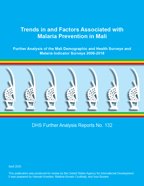There is no printed copy available to order.
Abstract:
This study uses data from Demographic and
Health Surveys (DHS) and Malaria Indicator
Surveys (MIS) conducted in Mali from 2006 to
2018 to assess regional trends in two key
areas of malaria prevention: the provision
and use of insecticide-treated nets (ITNs),
and protection against malaria in pregnancy.
Trends during the study period reflect the
increased investment in these two areas.
While comparison of national trends is
limited by the exclusion of the northern
regions in 2012-13 and 2015, and the security
concerns that affected sampling in Kidal in
2006, 2010, and 2018, the regional trends
between surveys support an overall positive
and significant improvement in the coverage
of ITNs and intermittent preventive treatment
in pregnancy (IPTp) throughout the country.
Trend analysis shows positive changes between
the 2006 and 2018 surveys in ITN indicators,
in response to ITN distribution through mass
campaigns, routine antenatal care (ANC) and
childhood immunizations, and sales of ITNs at
shops and markets. The use of ITN by pregnant
women and children under age 5 has
consistently been at least 70% since 2010,
and population ITN use is nearly equal to
population access to an ITN, which reflects a
strong culture of ITN use. Although the
percentage of women who received at least
three doses of sulfadoxine-pyrimethamine
(SP)/Fansidar (IPTp3) coverage has
significantly increased since 2006, and has
continued to increase with each survey,
overall rates of IPTp3 remain below 30%, with
significant gains from 2015 to 2018 limited
to the Bamako and Koulikoro regions. In 2018,
fewer than half of women who made at least
four ANC visits received at least three doses
of sulfadoxine-pyrimethamine (SP). This
reflects significant missed opportunities to
provide IPTp. However, since 2012-13,
nationwide gains in IPTp3 appear to be due
primarily to an increase in IPTp provision,
rather than increased ANC attendance. The
rates of ANC4 have not changed significantly
since 2012-13 in any region. This suggests
that the increased investments in provider
in-service training, refresher training, and
supply chain management for SP are likely
responsible for the progress in IPTp3 rates.
There are clear disparities in ITN and IPTp
coverage between the central/southern and the
northern regions. Since 2012, insecurity in
the northern areas has impeded implementation
of malaria prevention activities. In 2018,
Tombouctou and Gao lagged behind the other
regions in all coverage indicators, although
net use indicators were as strong as in the
rest of the country.
 Trends in and Factors Associated with Malaria Prevention in Mali (PDF, 8624K)
Trends in and Factors Associated with Malaria Prevention in Mali (PDF, 8624K)
